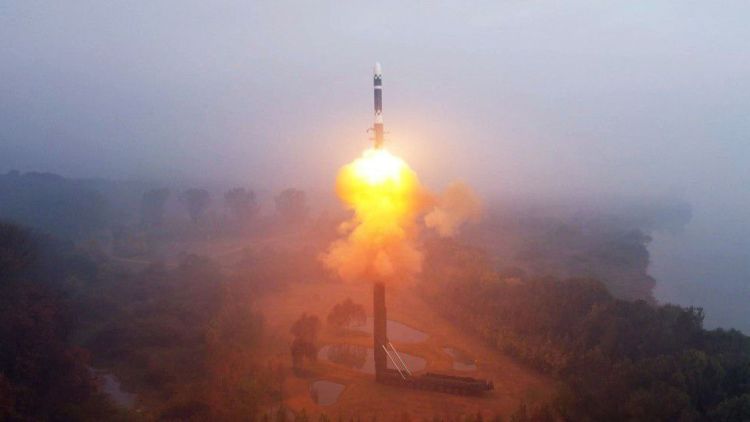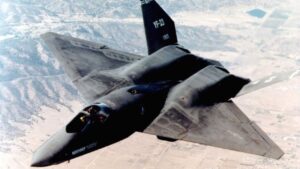North Korea fired off its newest solid-fuel intercontinental ballistic missile (ICBM), the Hwasong-19, on Thursday, October 31, showing off some serious advancements in military technology.
Dubbed “the world’s strongest strategic missile” by North Korean state media, this test has stirred up plenty of global concern.
Not only did the missile reach a record-breaking altitude and range, but its launch came just days before a US presidential election—a timing that doesn’t seem accidental.
So, what does this latest launch mean, and how did North Korea get here?
The Launch: Reaching New Heights
The Hwasong-19 launch on Thursday took things to an unprecedented level—literally.
According to both North Korea and tracking data from South Korean and Japanese militaries, the missile hit a maximum altitude of 7,687.5 kilometers (or roughly 4,776 miles) and traveled 1,001.2 kilometers (about 622 miles) before landing in the sea between Japan and Russia.
This trajectory not only highlights North Korea’s reach, but it also underscores just how advanced this missile has become.
Kim Jong Un was on-site for the launch, which, according to the Korean Central News Agency (KCNA), went precisely as planned.
North Korea fired off its newest solid-fuel intercontinental ballistic missile (ICBM), the Hwasong-19, on Thursday, October 31, showing off some serious advancements in military technology.
Dubbed “the world’s strongest strategic missile” by North Korean state media, this test has stirred up plenty of global concern.
Not only did the missile reach a record-breaking altitude and range, but its launch came just days before a US presidential election—a timing that doesn’t seem accidental.
So, what does this latest launch mean, and how did North Korea get here?
The Launch: Reaching New Heights
The Hwasong-19 launch on Thursday took things to an unprecedented level—literally.
According to both North Korea and tracking data from South Korean and Japanese militaries, the missile hit a maximum altitude of 7,687.5 kilometers (or roughly 4,776 miles) and traveled 1,001.2 kilometers (about 622 miles) before landing in the sea between Japan and Russia.
This trajectory not only highlights North Korea’s reach, but it also underscores just how advanced this missile has become.
Kim Jong Un was on-site for the launch, which, according to the Korean Central News Agency (KCNA), went precisely as planned.
Solid-fuel technology is a key development in missile capabilities, allowing for quicker launch times and increased mobility—traits that make it harder for adversaries to detect and intercept.
The Hwasong-19 is North Korea’s most ambitious step toward a more credible nuclear deterrent.

Why Solid-Fuel Technology Matters
Solid-fuel technology has been a long-time goal for North Korea’s missile program.
Unlike liquid-fuel missiles, which require a lot of prep and fueling just before launch, solid-fuel missiles can be stored, transported, and launched with much less logistical fuss.
For North Korea, this means their missiles are not only quicker to launch but also more mobile and stealthy, increasing their survivability in a potential conflict.
The Hwasong-19 also showcases impressive thrust and range capabilities, thanks to increased fuel capacity. It’s designed to carry heavier payloads, which means it could potentially transport multiple nuclear warheads or larger ones.
There’s still some debate over how well North Korea can control these warheads during reentry, but North Korea seems determined to overcome this hurdle.
The Timing: A Strategic Move
The timing of this launch wasn’t random. It took place just days before the US presidential election, a move likely meant to get Washington’s attention and remind the world of North Korea’s expanding nuclear capabilities.
North Korea’s leader has a habit of scheduling big tests around major political events, making sure their presence—and their demands—aren’t ignored.
With global attention on the US election and other geopolitical issues, this launch signals that North Korea remains committed to its missile program, regardless of any diplomatic discussions.
Kim Jong Un even described the launch as evidence of North Korea’s “irreversible” position as a nuclear power.
International Reactions: Strong Condemnation
Predictably, the international response to the Hwasong-19 launch was swift. The US, South Korea, Japan, and even the United Nations condemned the test.
Washington warned that Pyongyang’s growing nuclear capabilities could destabilize the region, while Seoul and Tokyo expressed concerns over their own national security.
The US and South Korean air forces conducted joint live-fire drone exercises the day after the launch as a show of military strength.
In addition to public condemnation, South Korea imposed sanctions on 11 North Korean officials and four entities connected to the missile program. These sanctions aim to tighten the pressure on North Korea, cutting off funding streams that might support further development of its missile capabilities.
Pyongyang-Moscow Relations: Military Support and Technology Concerns
Adding another layer of complexity, the launch also follows recent reports that North Korea has deployed troops to Russia to aid its war efforts in Ukraine.
While Pyongyang denies these claims, both the US and South Korea have noted the presence of thousands of North Korean troops near Ukraine’s front lines, raising concerns about an expanding alliance between North Korea and Russia.
The possibility of Russia sharing sensitive military technology with North Korea in return for this support has been a hot topic.
While experts believe Russia may hesitate to share top-level tech, even a basic exchange of military know-how could strengthen North Korea’s missile capabilities.
Russian support, in any form, could significantly bolster North Korea’s own defense industry and accelerate developments in missile and nuclear technology.
What’s Next?
The Hwasong-19 is just the latest example of North Korea’s relentless drive to strengthen its nuclear deterrent, and this recent launch serves as a clear signal to its adversaries, especially the United States.
With a missile capable of reaching nearly anywhere in the US and new support from Russia, North Korea seems determined to solidify its position on the global stage. And as international condemnation grows, North Korea’s response shows no signs of backing down.
For now, the world is watching closely, as each new launch brings questions about what North Korea’s next move will be—and how the international community will respond.



